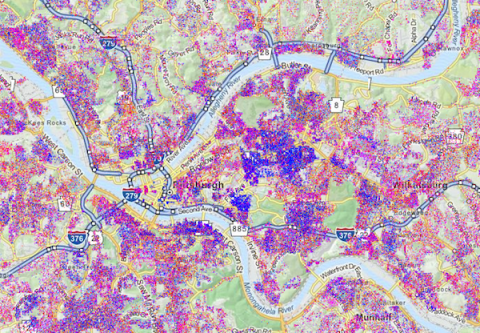Lindsay Hirschhorn (Mechanical Engineering) and Kelsey Sumner (Global Health and Evolutionary Anthropology) spent ten weeks determining optimal vaccination clinic locations in Durham County for a simulated Zika virus outbreak. They worked closely with researchers at RTI International to construct models of disease spread and health impact, and developed an interactive visualization tool.
Project Results
Using a simulated population of Durham county based on the 2010 UC Decennial Census, the team developed a model for disease spread based on transmission characteristics of Zika virus. They then determined optimal placement for vaccination clinics to minimize public health impact with several clinic placement algorithms including Cover Tree assignment, recursive removal of vaccinated population, and geospatial proximity to clusters of residents. Kelsey and Lindsay also developed an R/Shiny application for interactive visualization of their results.
Download the Executive Summary (PDF)
Faculty Lead: Paul Bendich
Project Managers:
- Thom Miano, Data Scientist, Center for Data Science, RTI International
- James Reneer, Spatial Data Scientist, RTI International
“I was very impressed by the Data+ program and would encourage both undergraduate students and employers to consider it as a strong opportunity for valuable experience and potential recruitment. The students involved in Data+ demonstrated excellence in scholarship, creativity, and output. The administrators and directors of Data+ have done a tremendous job in creating a learning environment that promotes cross collaboration, drives innovation and creative problem solving, and provides enough structure and mentoring as to guide students to successful outcomes. We will continue to stay in contact with Data+, and we look forward to another potential sponsorship in the future.” Thom Miano, RTI International
Participants
- Kelsey Sumner, Duke University Evolutionary Anthropology & Global Health
- Lindsay Hirschhorn, Duke University Mechanical Engineering
Disciplines Involved
- Public Health
- Applied Mathematics
- All quantitative STEM
“Working with Data+ for the past two summers has taught me not only new data analysis techniques but also the importance of collaboration and sharing ideas. This summer, my team’s project was focused on Zika virus vaccination clinic location optimization. To determine the best locations for clinics, we created a disease spread simulation and calculated the number of days to vaccinate the population to herd immunity. The simulation was a great way to choose the best clinic distribution model; however, it was difficult to effectively present the disease transmission simulation to an audience. After hearing Matt Ross present about his project last year creating interactive Shiny Apps, we started an application under the mentorship of Matt and Data+ 2015 intern, Molly Rosenstein. With their help, my team was able to create an interactive Shiny App within a week. This fast-paced, in-depth learning process is something only found in a multidisciplinary environment like Data+.” Kelsey Sumner, Evolutionary Anthropology & Global Health major




